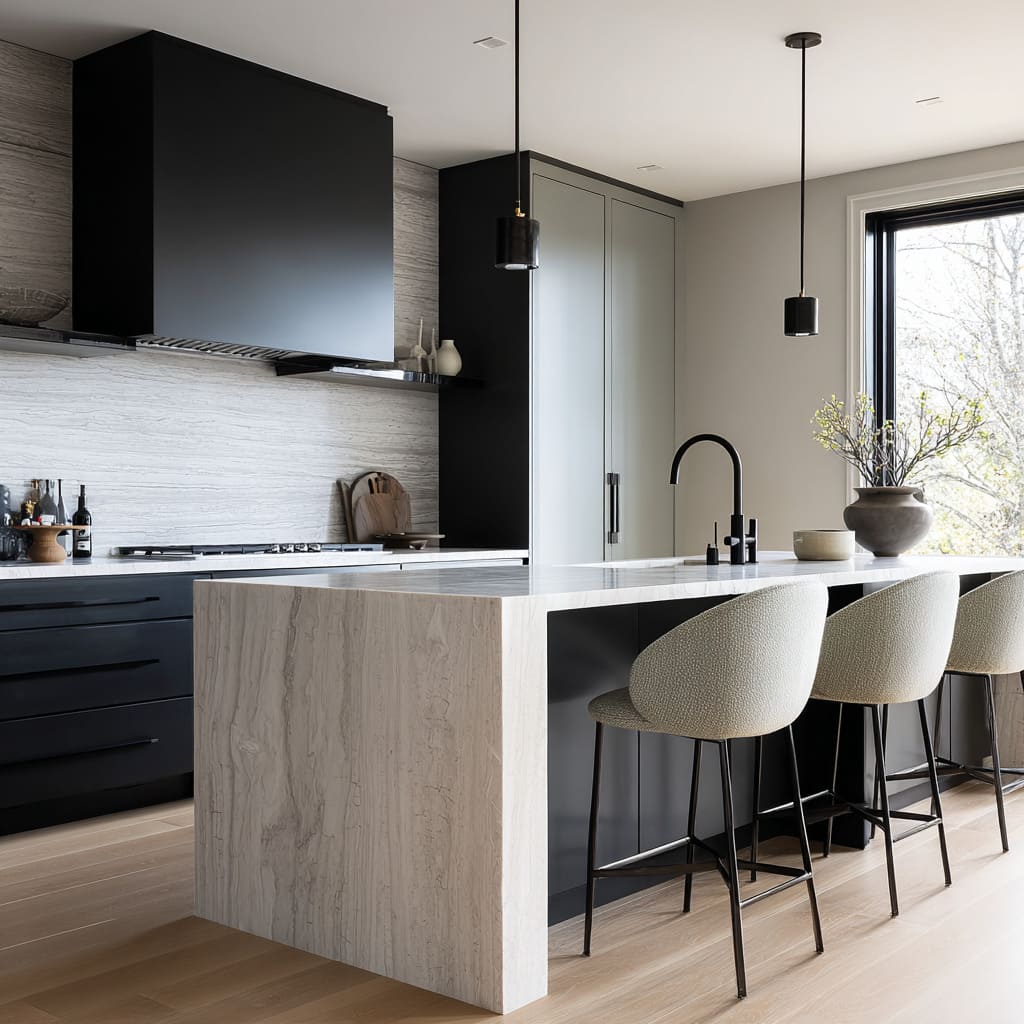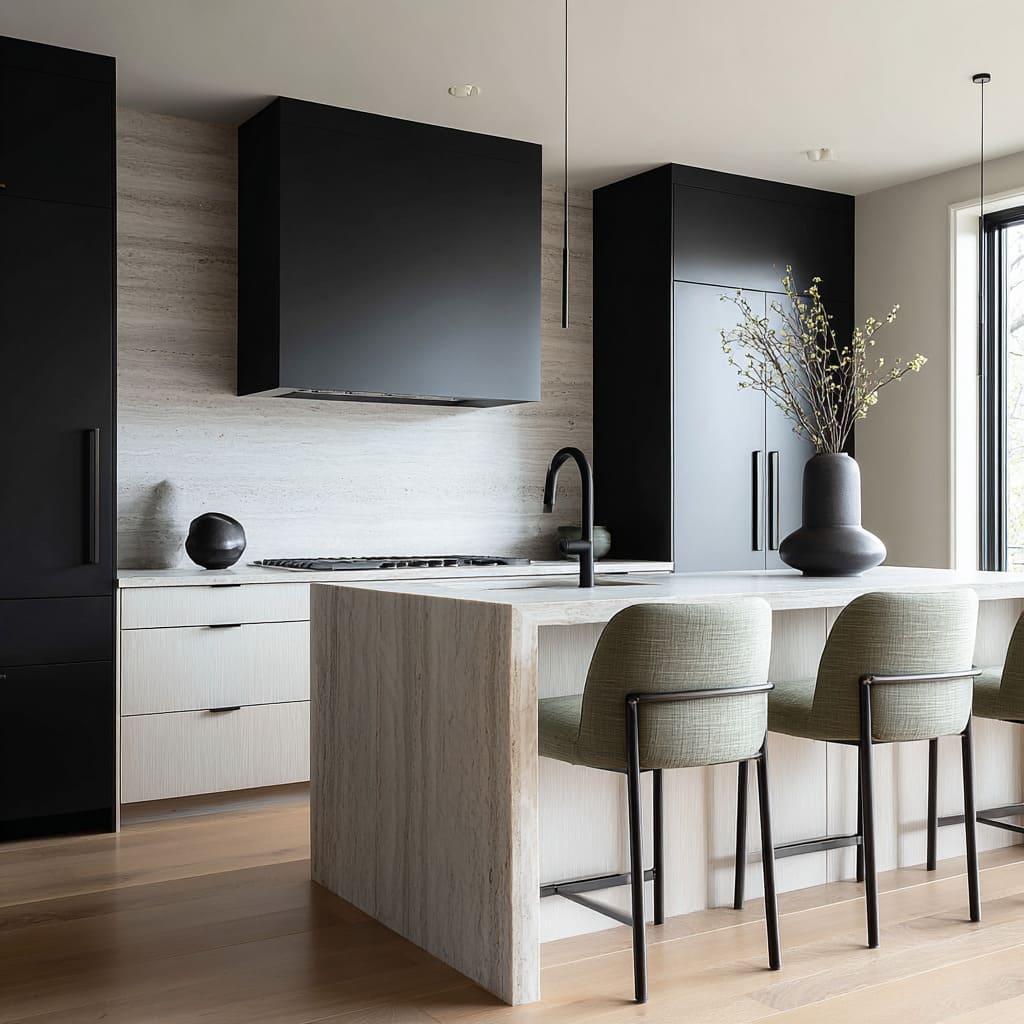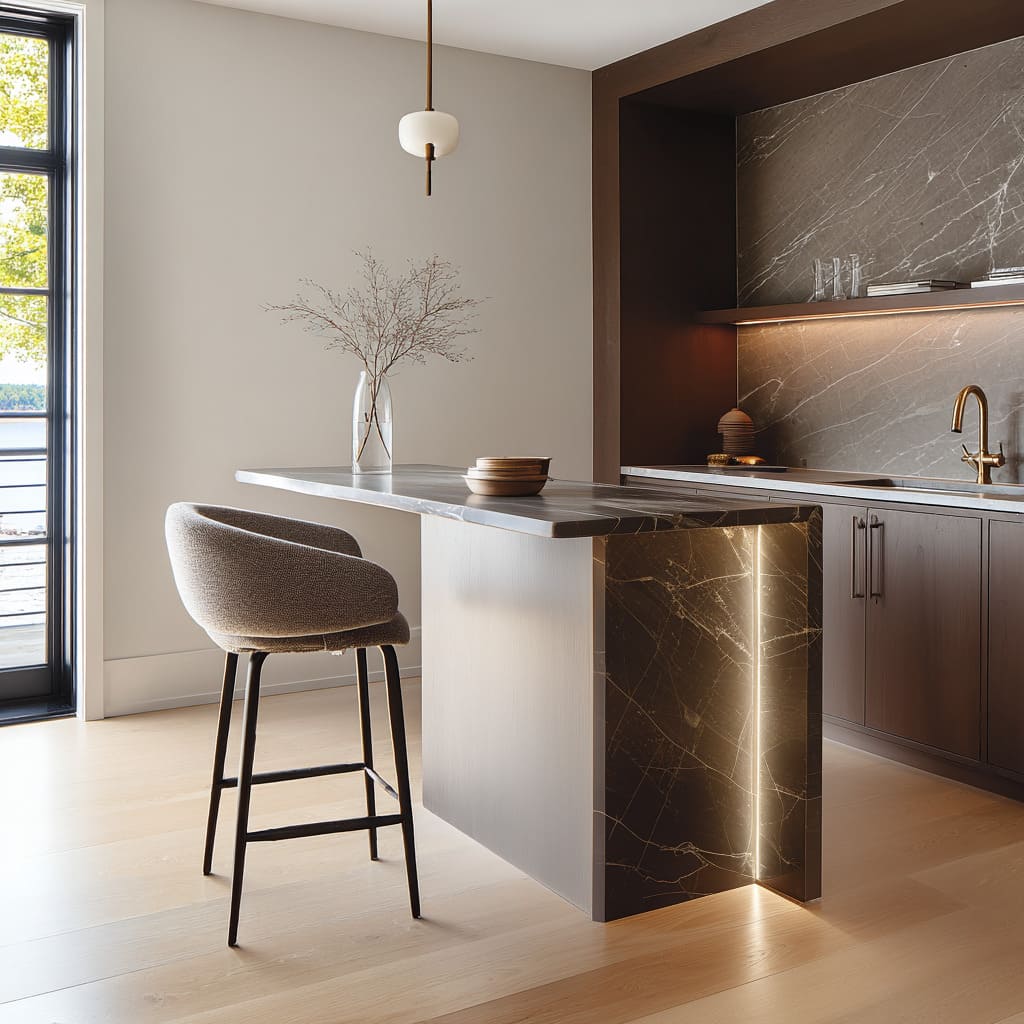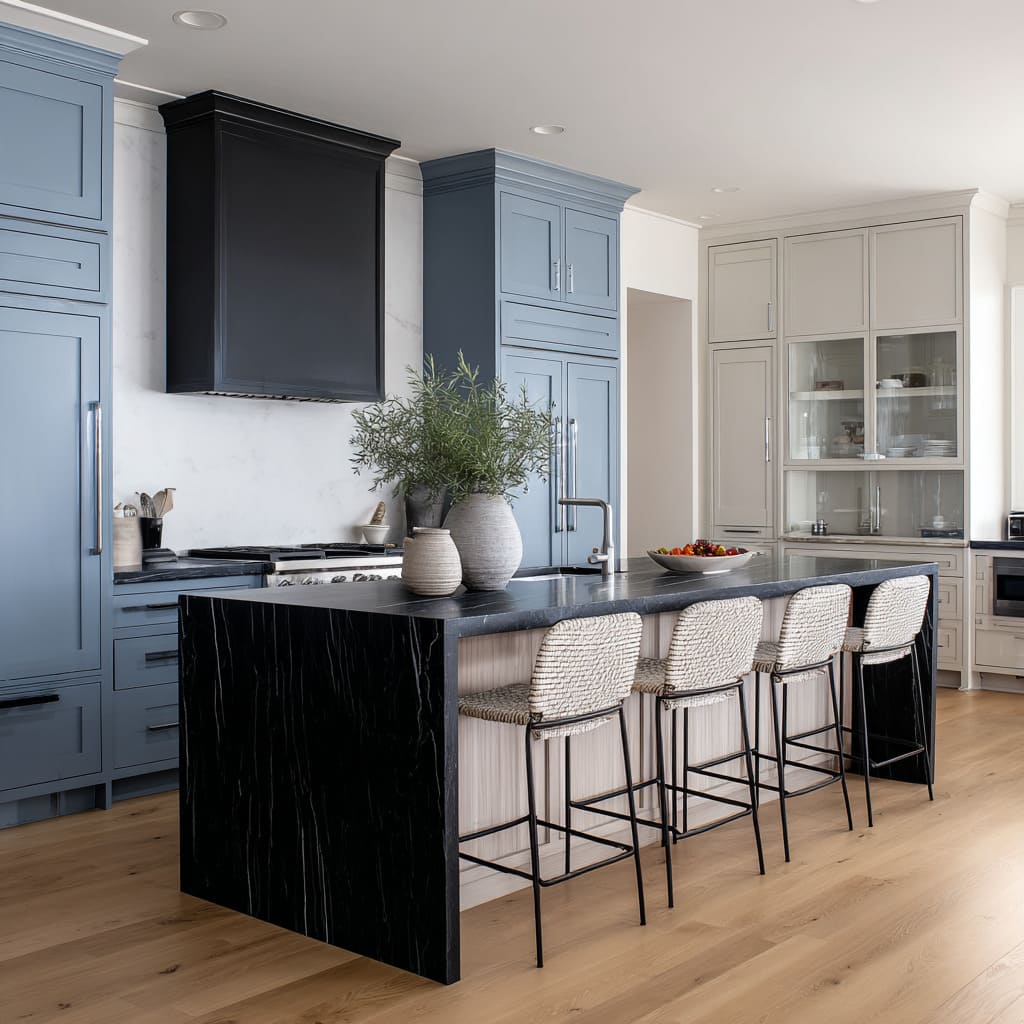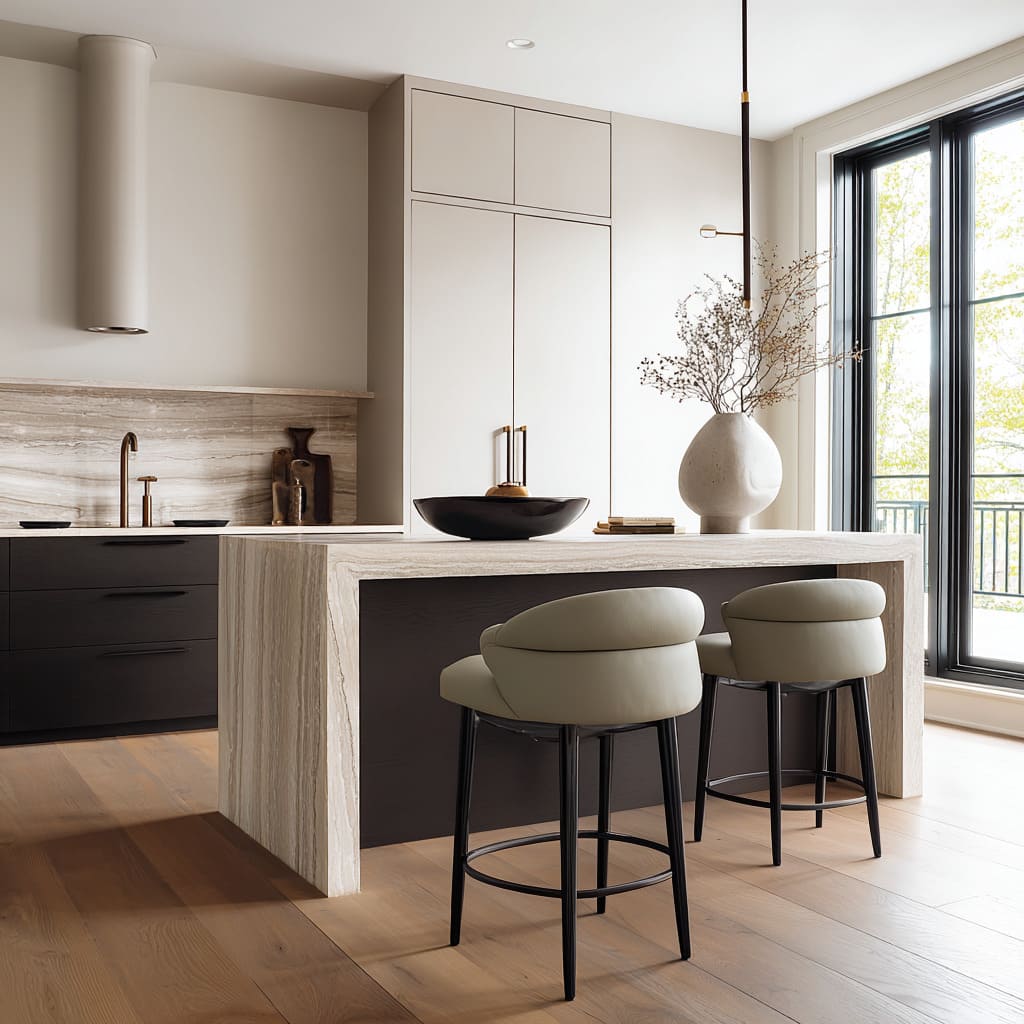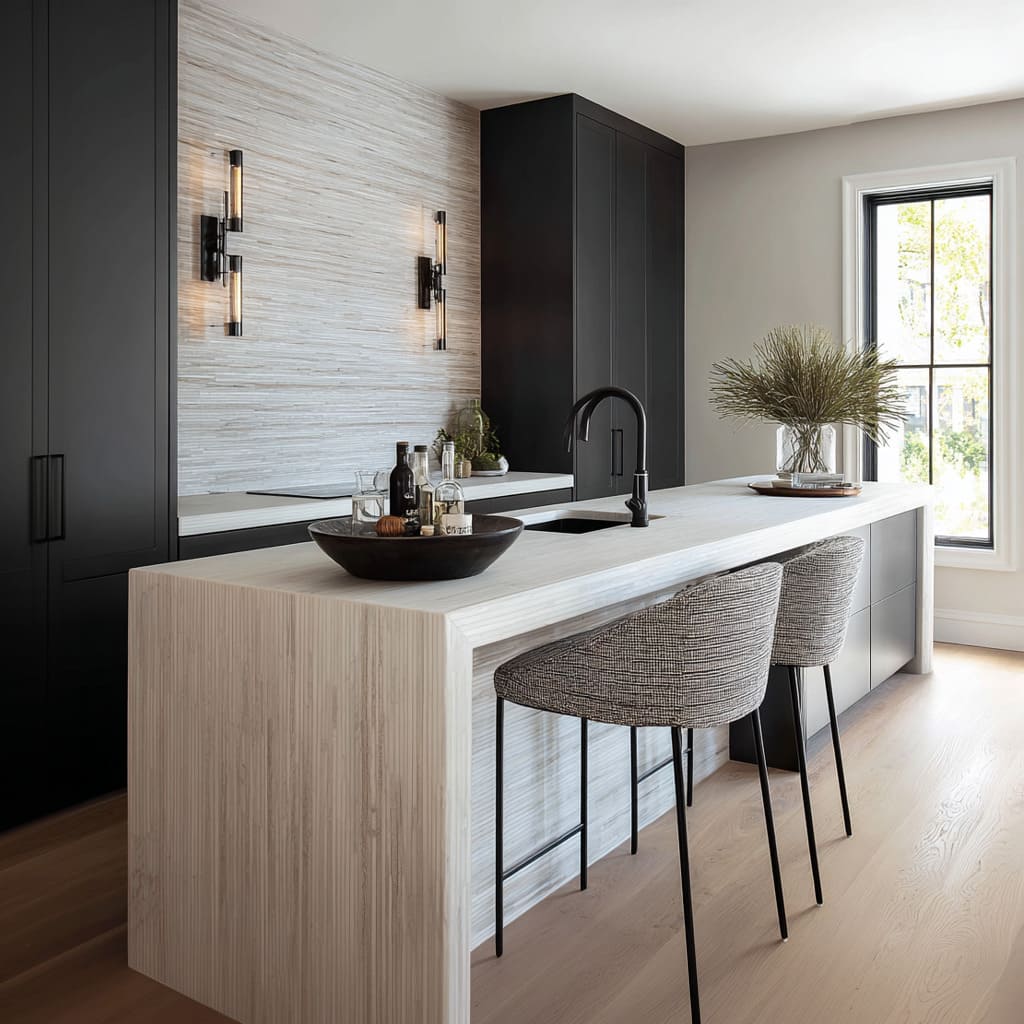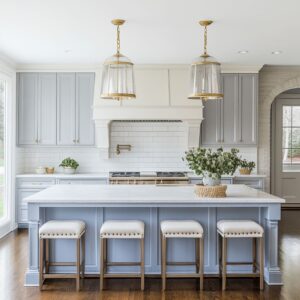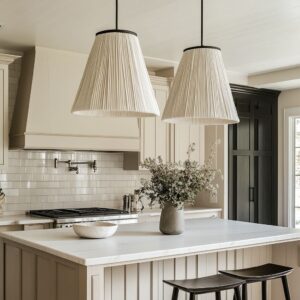Modern island seating often acts as the quiet organizer of the entire room, especially in spaces where stone, oak, and matte black accents already carry a lot of visual weight. In many interiors with pale stone waterfalls, slim counter reveals, and handleless cabinet faces, the stools decide whether the island feels strict and architectural or relaxed and lounge-like.
Designers treat bar stool ideas for white kitchen layouts as a way to tune the mood: a row of compact, squared-off seats can keep the island feeling sharp and linear, while cocooned shells, bolster backs, or armchair-style forms soften the outline and add a human note. Even the basic decision between a single perch at a cantilevered slab or a quartet lined evenly under a long overhang changes the reading of the room.
A lone barrel-back stool under a glowing peninsula feels like a small café corner; three or four identical seats, spaced with methodical gaps, turn the island into a social spine that anchors the whole space. In such kitchens, the stools hold the softest surfaces and the roundest curves, which means they often become the main place where comfort, texture, and color temperature are negotiated.
How “White” Connects Stone, Wood and Metal
Behind many refined white kitchen bar stool ideas sits one subtle trick: the “white” is rarely pure. Upholstery tones are adjusted in small steps so they can bridge pale stone, warm timber, and dark metals without calling attention to themselves.
Cream boucle cushions under travertine-style veining introduce just enough warmth to keep the stone from feeling cold, while a cylindrical tan leather roll along the top of each back quietly repeats the tone of nearby oak cabinetry and wooden bowls. In another composition, alabaster leather with a whisper of sage-gray connects travertine, oak flooring, and black window frames in a single move, keeping the overall impression light while avoiding an icy cast.
Slight green or beige casts let stools sit beside black pantry towers and banded stone walls without looking overly bright or clinical; the seat fabric becomes the mediator between strong dark planes and pale stone edges. This is color work done at the level of half-tones instead of bold accents: a warm oatmeal mélange of off-white and beige threads reads light from a distance but holds its own against bronze taps and chocolate cabinetry.
In such kitchens, the seat color often carries the midpoint of the palette, sitting between the brightest counters and the deepest cabinet faces so the eye slides gently from one material to another.
Texture: Bouclé, Tweed, Rope and the Micro-Drama of Surfaces
The texture of white bar stools for kitchen islands is tuned with the same care as the veining in the marble or the grain in the oak. Large travertine rivers, ribbed waterfall cladding, and paneled doors set up a backdrop of lines and bands; the fabric on the seat introduces a different scale so the scene does not collapse into a single flat field.
Pebble-grain boucle loops catch tiny shadows and highlights, making the cushion read soft and cloudlike, while still keeping the silhouette crisp. Micro-bouclé behaves differently: from a few steps away, it compresses into a smooth tone; up close, the tiny loops reveal a quiet liveliness, ideal for monochrome schemes where warmth comes from grain instead of color.
Tweeds and basketweaves create another register of texture, using chalk, ash, and graphite threads to mimic the mottled feel of stone without copying its pattern. In some kitchen designs, a diagonal tweed grain runs obliquely to the vertical ribs of a waterfall island, creating a soft moiré effect that only appears when the eye lingers.
Rope weaves introduce yet another behavior: strands flatten on tight turns and round out along spans, so light moves across the seat in alternating bands, giving a subtle coastal rhythm that works well beside blue cabinetry and black stone.
Common fabric strategies for white island seating include:
- Generous boucle with big loops – adds a relaxed, cloudlike softness that stands out against sharp stone edges.
- Micro-bouclé or tight basketweave – reads calm from a distance and avoids visual noise in veined or highly lit spaces.
- Salt-and-pepper tweed – mixes very light and slightly darker threads to hide day-to-day marks and echo streaked stone or dark fixtures.
- Off-white rope or cord – introduces a slightly rustic or coastal note while still maintaining a neutral palette.
Each choice sets the “zoom level” of texture, so that stone, wood, and textile play at different scales instead of fighting for attention.
Shapes: Shells, Barrels, Bolsters and Blocks Around the Island
The silhouettes of white kitchen stools trace different attitudes toward the island and the surrounding cabinetry. Shell stools with generous ovals—wide through the hips, pinched at the waist—create a feeling of snugness where the cheeks of the waterfall island frame the seat.
That snug gap looks intentional, almost like a built-in bay, and the curved shell softens the strict geometry of vertical grooves and straight stone edges. Barrel-back stools form another family, with slimmer, more upright arcs that suggest an alert yet comfortable posture.
Squared shoulders on those barrels align neatly against paneled doors or thick stone edges, keeping the horizon tidy and preventing the backs from protruding as bumps along the counter line.
Bolster-backed designs introduce a different language: cylinders of boucle set inside black cubic frames, or horizontal rolls perched over firm seat blocks, read almost sculptural. They provide support at the waist while demonstrating clear geometric relationships—circle inside square, soft shape inside hard outline.
Pedestal ovals on disc bases focus on floor clarity rather than outline complexity, removing leg clutter and letting hybrid counters shine. Altogether, these shape families determine whether the island feels like a lean work counter, a relaxed lounge edge, or a formal social bar, without a single change to the stone or cabinetry.
Key shape directions often seen
- Cocooned shells: continuous curves from arm to back, ideal for turning hard-edged islands into more welcoming bays.
- Compact barrels: mid-height, neatly tailored arcs that partner well with linear, shaker, or slab millwork.
- Bolster-on-block forms: cylindrical backs on cubic bases that emphasize architectural clarity.
- Armchair-style stools: modest, slightly canted arms and boucle seats that bring a hint of living-room comfort to the counter.
Horizons, Back Heights and the Calm of Unbroken Stone
Back height can be treated with impressive precision, particularly in spaces where the stone backsplash or waterfall slab is the main visual statement. Designers often align the top of the back roll or cushion just under the counter edge so the slab remains the primary horizon line; the stools sit like a soft underline rather than a barrier.
In kitchens where the backsplash vein flows diagonally, the backs are cut lower, allowing the marble pattern to read like a continuous drawing behind the island. Mid-height backs that dip in the center or slope gently toward the arms ensure that faucets and sculptural taps remain the tallest dark verticals, so the eye reads fixtures and stone as the main composition, with the seating as a secondary layer.
This careful relationship between stool height and stone plane prevents visual clutter, especially in rooms with tall lanterns, strong vent hoods, or bold bookmatched slabs. In long islands where three or four seats are used, the ends of bolster rolls often stop just shy of the stone thickness, avoiding any sense of protrusion beyond the counter and keeping the silhouette crisp from side views.
These subtle decisions allow white stools for kitchen island layouts to contribute comfort and presence without competing with the architectural surfaces that give the kitchen its core identity.
Black Frameworks, Alignments and the Way Bases “Stitch” into the Architecture
Under all the pale upholstery, thin black frameworks act like a drawn sketch that connects seating to the wider architecture. Needle-thin legs echo black window frames, slim faucets, cabinet pulls, and pendant stems, turning the metalwork into one continuous graphic language.
Sled bases lean forward slightly to repeat the dynamic push of a waterfall island, while square stretchers align with island support panels so the stool outline underlines the mass above. In some compositions, front foot bars land exactly in the same band as a shadow groove under the counter, so the stool appears anchored to that joint rather than floating awkwardly in front of it.
Disc pedestals replace four legs entirely in mixed-material counters where a wooden ledge intersects veined stone; the clean circle declutters the floor and lets the special counter detail take center stage. Black metal rails sometimes match the height of inner drawer lines or panel rails, so that a row of stools appears to “lock” into the island rhythm.
This careful alignment work keeps the zone under the island visually quiet, even in deep overhangs or shadowed niches. It also ensures that the stools feel like part of the architecture rather than separate furniture moving through the space.
Light, Shadow and the Behavior of Pale Upholstery Through the Day
Light plays a decisive role in how white island seating behaves, especially where large windows or strong artificial lighting accent the bar area. Barrel-back stools upholstered in tight basketweave glow softly under direct sun, each curve catching a clear highlight and tracing a wave along the row, while their structured weave prevents harsh glare.
Pebble bouclé loops in front of a mirrored or glass-backed niche scatter small highlights like beadwork, adding shimmer without overwhelming the stone and timber around them. In darker, moodier kitchens, warm oatmeal tweed seats sit in front of backlit plinths or glowing support panels; the light washes upward, creating a gentle gradient on the fabric and turning the stool into the main soft element among dark marble and bronze taps.
Even minor choices in weave scale and sheen dictate how light flows: matte micro-bouclé keeps reflections calm in highly veined backsplashes, while slightly lustrous rope or linen mixes echo the shine of metal details and window glass. Through these decisions, white seating becomes an instrument for choreographing brightness, ensuring that the bar side feels welcoming in morning light, evening task lighting, or the dim glow of concealed LEDs.
From Quick Perch to Soft Lounge Edge
Finally, the arrangement and style of seating define how the island space is likely to be used, even before anyone sits down. A single, slim barrel beside a cantilevered slab suggests a small café moment in an otherwise serious kitchen, a spot that suits a laptop, a notebook, or quiet coffee.
A pair of pedestal stools in front of a hybrid counter with a walnut “bookmark” ledge reads almost ceremonial, as if both seats have a designated bay at the bar. Shells and armchair-style stools, especially in sets of three under deep overhangs, hint at longer conversations and relaxed meals, with wide curves and occasional arms that invite sideways sitting and informal posture.
Compact tweed barrels on sled bases suggest brisk daily rhythms: breakfast, quick snacks, kids doing homework while dinner is prepared, all in a setting that still respects sharp island geometry and strong cabinet lines. Rope-woven seats in front of blue millwork and a dark stone waterfall introduce a relaxed, near-coastal mood that lightens the effect of heavy slabs.
In these arrangements, white kitchen island stool ideas function as social cues as much as aesthetic ones; upholstered shells, bolsters, barrels, and pedestals quietly express whether the island behaves as a workstation, a social node, a compact lounge zone, or a hybrid of all three inside a calm, pale kitchen.
